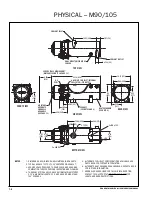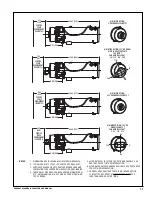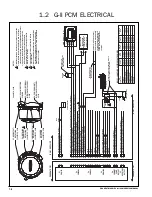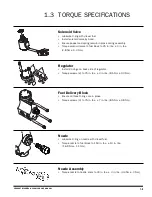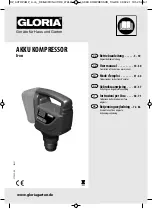
THEORY OF OPERATION
There are four basic systems within the Proheat.
The purpose of the Air compressor is to deliver a metered amount of clean
compressed air to the nozzle.
As the blower motor turns it drives a diaphragm type compressor through a
set of gears. The compressor draws fresh air through an Air filter located on
the PCM. Its then compressed and delivered to the nozzle.
The purpose of the fuel supply system is to deliver clean, air free fuel to the
fuel regulator.
As the blower motor turns it directly drives a positive displacement type gear
pump. The fuel pump draws (under a vacuum) fuel from the fuel tank through
the fuel line. The fuel then enters the Sintered fuel filter located behind the
fuel fitting on the burner head. The fuel then passes through the Fuel delivery
block inlet Screen and enters the fuel pump gears. The fuel pump then
pressurizes the fuel to 5–10 psi. This pressure is controlled via the fuel
pump relief valve. The fuel then passes through Regulator Screen and enters
the fuel regulator. The fuel regulator then reduces the fuel pressure to 0 PSI.
The fuel is now drawn from the regulator by the low pressure created by the
nozzle (like a carburetor float bowl).
The purpose of the Nozzle is to atomize the fuel and set the fuel/air ratio.
The compressed air travels over the body of the nozzle, as it reaches the end
of the nozzle it passes through a restriction. This creates a negative pressure
or venturi effect (like a carburetor). This negative pressure extends back through
the centre of the nozzle all the way to the fuel regulator. This negative pressure
causes fuel to be siphoned from the fuel regulator (like a carburetor float bowl).
The compressed air and fuel are then mixed at the end of the nozzle into a
very fine mist of fuel/air that is sprayed into the combustion chamber in the
shape of a cone.
The purpose of the Combustion system is to deliver a metered amount of air to
the combustion tube. This provides the majority of the air needed to combust the
atomized fuel/air mist created by the nozzle. And also cool the combustion
chamber when the heater cycles off.
As the Blower motor turns it directly drives the combustion air blower blade.
The combustion air is not filtered so it needs to come from a clean area. A
snorkel hose is sometimes used to draw air from a clean source. The air is
then directed into the combustion tube. The combustion tube is shaped in
such a way that it causes the air to swirl. The swirling air then mixes with the
atomized fuel/air cone from the nozzle. Once lit this create an intense flame
in the combustion tube. The hot gases then reach the end of the combustion
tube and make a 180 turn to enter the heat exchanger. The heat exchanger
has fins that transfer the heat to the coolant that flows around the heat
exchanger. The gases then enter the exhaust system and are directed away
from the vehicle.
All four systems must work together to produce safe, smoke free operation
of the Proheat.
It is important for the service technician to understand the four systems and
how a change in one system can result in improper combustion.
2.2
1. The Air Compressor
2. The Fuel Supply System
3. The Nozzle
4. The Combustion
Air System
2-4
PROHEAT M-SERIES G-II PCM SERVICE MANUAL
Summary of Contents for M105 G-II PCM
Page 7: ...PROHEAT M SERIES G II PCM SERVICE MANUAL B 2 ...
Page 11: ...PROHEAT M SERIES G II PCM SERVICE MANUAL D 2 ...
Page 25: ...PROHEAT M SERIES G II PCM SERVICE MANUAL 1 12 ...
Page 35: ...2 10 PROHEAT M SERIES G II PCM SERVICE MANUAL ...
Page 77: ...PROHEAT M SERIES G II PCM SERVICE MANUAL 4 40 ...
Page 89: ...6 2 PROHEAT M SERIES G II PCM SERVICE MANUAL ...



